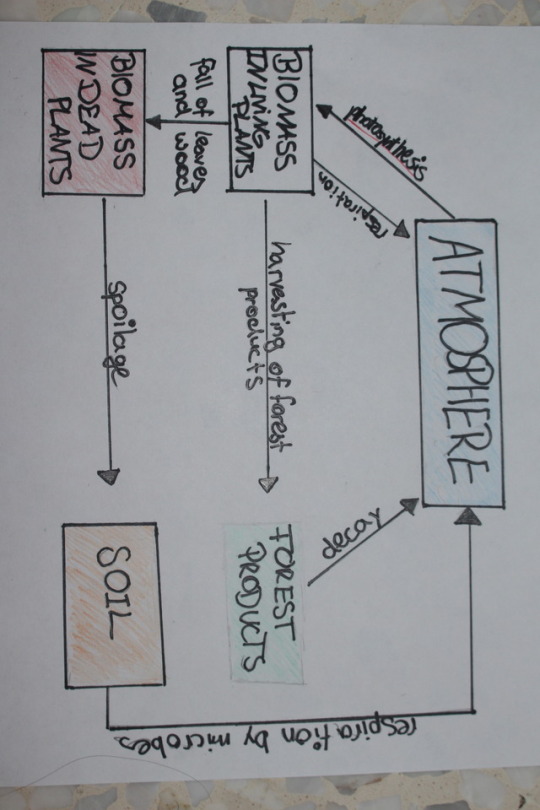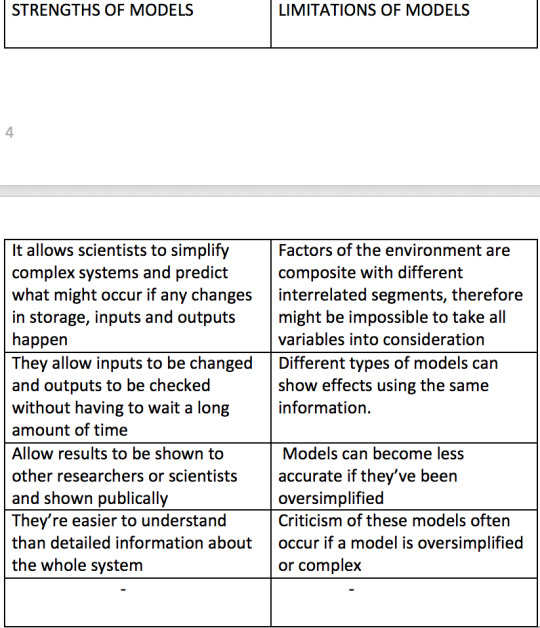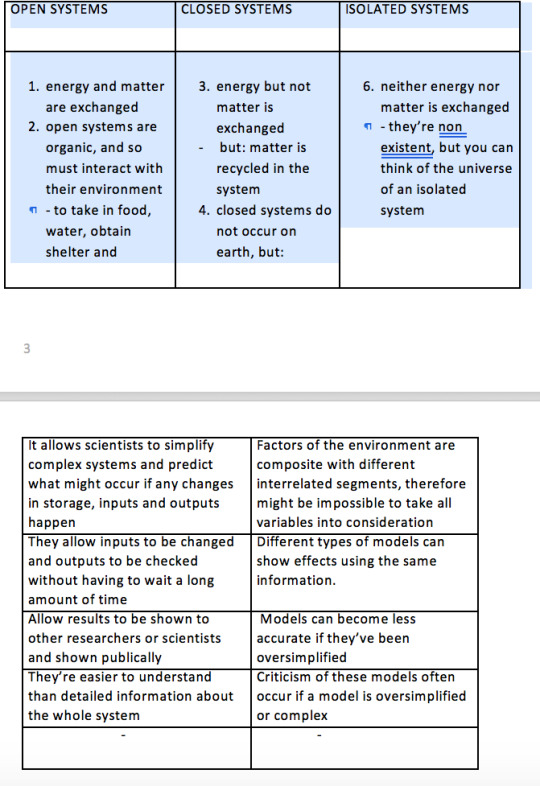Text
BIOSPHERE 2 QUESTIONS
1. Maybe because the current ecosystems and environments are a part of Biosphere 1, whereas biosphere 2 is the artificial environment created to experiment for science.
2. Why did the Biosphere 2 idea start?
To furthermore study the ecosystems existing in Biosphere 1
To test if the life within an artificial environment of the Earth’s life-supporting environment could be sustained.
To recreate communities and environments the earth has (EXAMPLE: savanna grassland, coral reef, desert, mangrove swamp)
3. Biosphere 2 has been described as a “closed system”. What does this mean?
•It means that it’s a man-made creation of a closed ecological system to sustain the life of individuals. As well as the occurrence of energy exchange only.
4. How long did Biosphere 2 last? Why?
It lasted 2 years due to the length of the experiment the scientists wanted to hold. And technical difficulties occurred, as well as the oxygen level start to fall and reached dangerously low levels. The human and social life was slowly being affected, because they realized that generating food to sustain themselves was a downfall. Even their association with the different plants and insects in Biosphere 2 was an issue, because they were inexperienced.
5. Biosphere 2 was designed to include some of the major ecosystems of the Earth. List the ecosystems and divide them into terrestrial (land based) and marine (sea-water based).
Terrestrial: (land based)
• rainforest
• savannah grassland
• a human habitat, and a below-ground level
• fog desert, agricultural system
Marine: (sea-water based)
• ocean with a coral reef
• mangrove wetlands
6. Do you think Biosphere 2 was a success or failure? Why? In a way i do think It was a success because scientists were able to plant their own food and were really having an insight on what they were consuming but the project didn’t hold for long to say that it was a successful project because as time passed by, they were reaching dangerous difficulties that could have put their life in risk.
0 notes
Text
SUMMER WORK PAGE 47
PG Nr. 47 1,2,3,4,5
Nr. 1
Natural Capital is used for resources that are able to produce sustainable natural income of goods or services. Which can be obtained from resources. An example for this is, the earth’s core and crust; the biosphere containing forests, deserts, tundra and other biomes. All of these resources are constantly and excessively used by humans in order to provide food, water, shelter and even life support systems.
Nr. 2
Sustainability means living, and being able to continue a defined behavior.
If humans are dependant on goods and services provided by different forms of natural capital is unsustainable. Long term harvests or pollution rates shouldn’t exceed the rates of capital renewal.
Nr. 3
Sustainable development defines as “meeting the needs of the present without compromising the ability of future generations to meet their own needs” It is said that this is a matter of a substantial debate, with said that there was no single definition for it. For instance, economists view substainable development as a “stable annual return on investment regardless of the environment impact” whereas some environmentalists might view it as a stable return but without environmental degradation.
Now a question asked is “Is sustainable development possible in long term?” people might think it isn’t because so many resources are being constantly used by so many people and it might end up not being enough for everyone. But only if people were not ready to reduce their standards of living. If new technologies found quick as possible in order to replace fossil fuels, non-renewable resources will run out if the use of renewable resources do not increase. More pressure is added to natural resources if there’s a low or incapability of the key factor; population growth.
Although everyone’s perspective is different and some may see that sustainable development is impossible, others may be on the contrary and see it as possible. Humans and technologists are able to develop technology to use renewable energy resources for our needs. Examples are micro-generation using wind turbines. This type of energy can provide energy for homes and factories. Hydrogen powered engine transport can be used to replace the need for fossil fuels. Less energy can be used by insulation of home or places of work. Even technological developments in growth of crops can mean more production. With all of these factors it’s definitely convincing that sustainable development is possible in long term.
Nr. 4
Sustainability is a word that comes from the word sustain. It means the ability to sustain. Sustain to hold for a long time. There is also a concept called sustainable development. Sustainable development has a deeper meaning for our environment, culture, economy and so on, that makes it a concept far more important for humanity. The differences between the two concepts will be outlined.
Sustainability contains the word sustains. Meaning having the ability to endure or continue for a long time. Sustainable development might sound similar but there are differences.
Sustainability applies to ecosystems and human beings along with their future on earth. Ecosystems and the environment has hanged rapidly over the past thousand years and humans have exploited natural resources. They also made approaches on agriculture to fulfill its needs and requirements.
We tend to speak of sustainable energy, ecosystems and sustainable development which will be my next point.
Sustainable development is a pattern like growth and development that meets the requirements of the present without influencing the capability of the future to seek their requirements.
Differences:
• Sustainability is the ability to hold on while sustainable development is a strategy to achieve development without compromising with the ability of our future generations to fulfill their needs
• Sustainability prioritizes the safety of the environment, while sustainable development focuses on development of infrastructure, keeping the environment clean, to achieve growth.
Nr.5
The EIA process keeps track of environmental issues and makes sure that they are displayed as a plan or project, so its discussed first and concerns are addressed to find solutions.
The EIA process includes:
- screening
- scoping
- prediction and mitigation
- management and monitoring
- audit
1. screening: results in categorizing of projects to be able to tell whether it’ll be carried out as a full EIA or not.
2. Scoping: the process on which issues are determined to examine or deeply study. The outline proposal of it can influence the EIA severely.
3. Prediction and mitigation studies follow “scoping” and carries with workability studies
4. Managing and monitoring: “main output report is called an ENVIRONMENTAL IMPACT STATEMENT and contains a detailed plan for managing and monitoring environmental impacts.”
5. Lastly: audit of the EIA is carried out after the decision taking. Its purpose is to give feedback.
0 notes
Text
SUMMER WORK-PAGE 37
nr 1
The first law of thermodynamics, also known as Law of Conservation of Energy, states that energy can neither be created nor destroyed it can only be transferred or changed from one form to another. Whereas the second law of thermodynamics states that the transfer and transformation of energy is inefficient with all energy ultimately being lost into the environment as heat.
Nr.2
A system that is in a steady state remains constant over time, but that constant state requires continual work. This condition is also referred to as a system in dynamic equilibrium. Where the process maintaining the system to terminate, the conditions would not remain. (steady-state equilibrium). Whereas static equilibrium have no in or outputs of matter nor of energy, in addition with no change in the system over time.
Ecological systems are highly sensitive to change most of the time, such as the removal of a species. A healthy ecosystem is said to be in equilibrium, which is a relatively stable state that keeps population sizes within a sustainable range.
Nr. 3
a) a natural system deflecting its equilibrium can be seen through global warming. Obviously the earths temperature/climate can develop a different equilibrium because over the past years, the climate and environmental conditions have changed drastically. A contribution to the drastic change of this equilibrium can include green house gases, pollution, cars and machines in factories.
b) systems undergo long-term changes to their equilibrium, while the integrity to the system, for instance succession. The system tends to return to the original equilibrium rather than adapting a new one that requires to be understood.
Nr.4
Diversity within systems can contribute to their resilience, which can moreover affect the speed of change.
For instances Rainforests have high diversity and through catastrophic disturbances like removal of biomass or or logging, can lower its resilience, meaning the time to recover takes quite a while.
0 notes
Text
SUMMER WORK-PAGES 17/25/37/47
pg 17
nr.1
1956:
o symptoms: damage to hearing, speech and vision, muscle weakness
o extreme cases: disease led to death, paralysis & insanity.
o Birth defects in new born children
1984:
- Union Carbide pesticide plant in Bhopal, India
- Release of 42 tonnes of toxic methyl isocyanate gas
- gas in tanks overheated and burst
- 500000 people were exposed to the gas
- 8000-10000 people had died within the first 72 hours
1986:
- Chernobyl plant in Ukraine exploded (major nuclear incident)
- Radioactive dust was sent into the atmosphere
o Fell over a large area (including parts of the Ukraine, Russia and Belarus were contaminated)
- Evacuation of 336000 people, and increased the incidence of cancer in most exposed areas
- Safety of soviet nuclear power stations particularly
- General safety of nuclear power worries everyone up until today
2011:
- Earthquake resulting into a tsunami in Japan, hitting the coastal Fukushima nuclear power plant
- Causes:
o meltdown in three of the six nuclear reactors
o radioactive material residue into the sea
- all reactors were shut down for safety checks
- nuclear had provided 30 percent of Japans energy needs
nr. 2
inputs: education cultural influences, religious doctrine, media, socio-political factors
outputs: perspectives, courses of actions determined by processing all inputs, decisions
nr.3
ecocentric:
Ecocentrism is a philosophy or a perspective that places the natural value on all living organisms and their natural environment. People following this perspective believe in the importance of an ecosystem.
Technocentric:
Technocentrism is the idea or value system of having or developing technology to be able to control and protect the environment. Technocentrists positively have faith and believe that today’s technological ideas can help the environment, believing that human beings do obtain control over nature.
0 notes
Text
TO RESEARCH - Look up these people who were involved in environmentalism and write three sentences on each (PT 2)
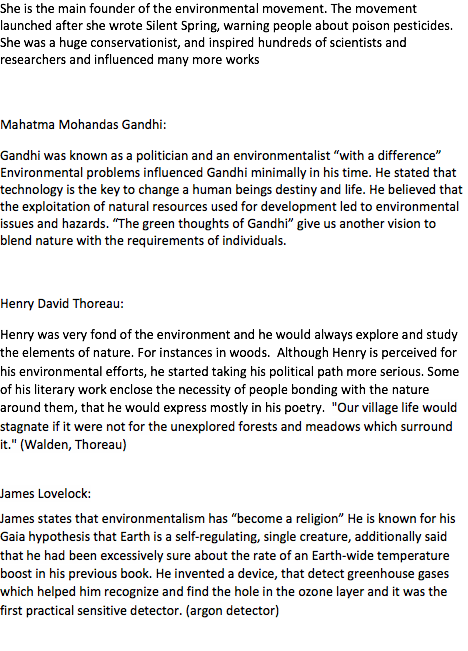
0 notes
Text
TO RESEARCH - Look up these people who were involved in environmentalism and write three sentences on each
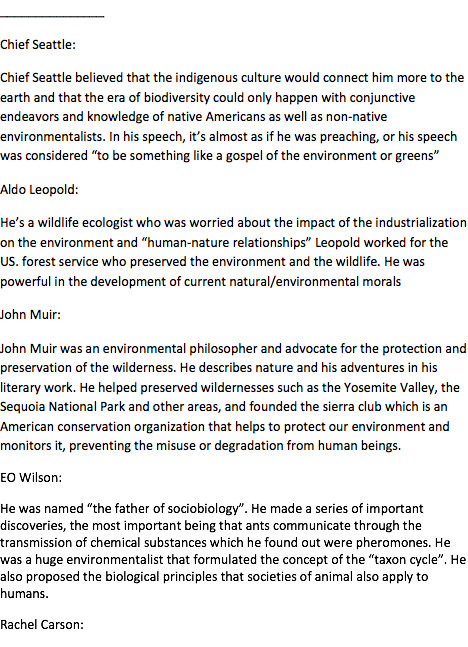
0 notes
Text
ESS homework - Eco/Technocentric views on acid rain reduction

0 notes
